| How to pack guitars and other instruments for shipping via UPS, FedEx, USPS, etc. | This is not rocket science, but it's well worth doing right. Damage claims against shippers are really messy, take forever, and seldom work out well. And problems are almost always avoidable with good packing. |
| More
about flying with them below |
|
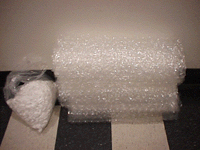 |
Items
needed (for a guitar, anyway):
1) a large guitar shipping box - the ones for good large guitars in cases, not the flimsy ones that are just for cases alone. These are usually free for the asking at your local guitar store. Get a good one, the bigger the better. Taylor and Martin have good ones. 2) bubble wrap or crumpled newspaper (use those horrid styro peanuts only if it's unavoidable—cases or other objects migrate through the peanuts to the inside surface of the carton and you no longer have good protection there). 2) 2" wide shipping tape. |
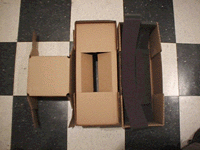 |
Shown here are the shipping inserts for typical acoustic guitar. These pieces help strengthen and support the box itself, as well as keep the guitar case centered. One goes in the bottom of the box to keep the butt of the case up an inch or so. The top one keeps the case's neck centered and at a safe distance from the top of the box. If you can get one of these boxes with the inserts, you'll need much less newspaper or bubble wrap. |
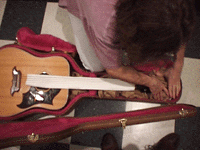 |
Always ship in a hard-shell case, preferably one with an arched top. Perhaps place a paper towel or cloth between the strings and fingerboard to prevent fret damage from the strings. If your packing is A+, the strings do not need to be loosened, though it is a good idea anyway. Pack crumpled paper in open areas of the case to prevent any shifting. Make sure there's nothing in the string pocket that can get loose in transit.
|
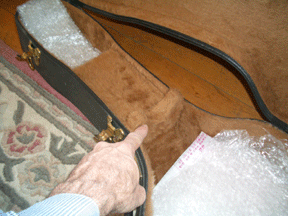 |
Pay
particular attention to the headstock. It's vulnerable
to whiplash inside the case, see below, and the neck
cradle here (and in most cases) is of little or no help.
You must use crumpled paper (or foam scraps,
whatever) front
and back to completely immobilize the headstock
inside the case. |
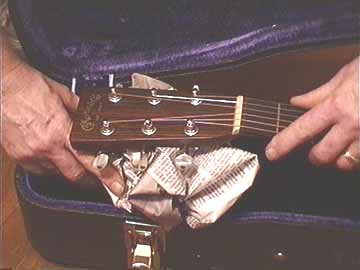 |
So, start with a big wad of crumpled newspaper under the peghead. And under the nut and the whole back of the headstock - enough paper to hold the peghead high in the case. |
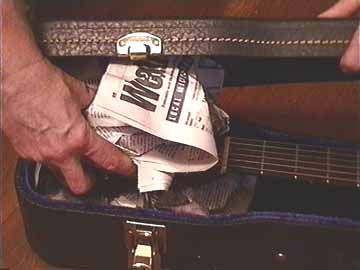 |
Then, a similar stuffing on top of the peghead, enough so that it's hard to close the case with the peghead suspended, equally supported on top and bottom. Let the paper compress. |
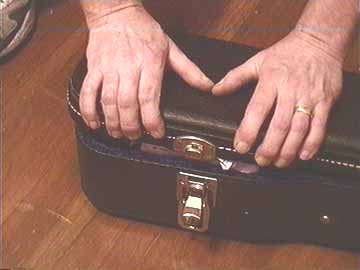 |
My pal
Frank Ford is pushing
hard here to close this case.
The idea is to keep the peghead from moving even a very little bit when the guitar case gets slammed down on the floor when the standing box tips over and falls flat. Or worse. This is the main cause for whiplash fractures. With
the case closed, shake it to make sure it's completely
immobilized inside, and that nothing is loose in
there. OK, box time. |
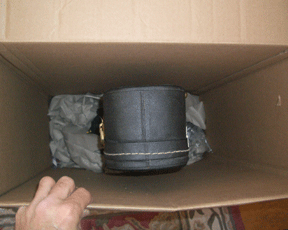 |
Secure
the bottom of the shipping box with an appropriate
insert, if you have one, or lay in a nice layer of
crumpled newspaper or bubble wrap to pad the butt of the
case. Lower the case in and check the distance from the
top of the case to the top of the box. An equal
clearance of an inch (at the very least) or three is
good. |
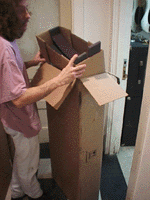 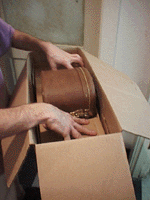 |
Place the neck insert, if you have one, around the neck area of the guitar case. This helps support the structure of the box, and prevents any side to side shifting. |
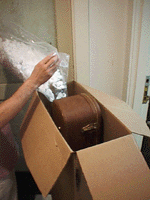 |
If you
don't have that neck insert, place the guitar/case in
the box on that thick cushion pad in the bottom, and
fill in all the space with bubble wrap, or
what-have-you, preferably lots and lots of crumpled
paper, all the way up. Old dogfood bags can be handy
here. Foam scraps, etc. You want to keep the front and
back of the case away from the sides of the box, so use
packing padding all the way around.
BTW, this case in the photo is too close to the top for my comfort. (I accumulated these images from around the 'net.) It should rest at least an inch down below the closed top. |
 |
Add more crumpled paper or bubble wrap to further secure the neck end of the case in the box. |
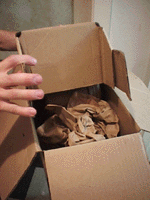 |
The point is to firmly immobilize the case inside the box so there's padding on all sides, and top and bottom. |
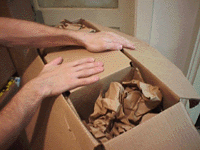 |
Further
secure the top with more paper, and firmly pack all
space to prevent shifting of the instrument.
It can't hurt to put a spare shipping label or a card inside the case before you seal it. |
 |
Tape
all sides, top and bottom. Tape around any part of the
box that is susceptible to ripping or tearing. In the
event that the box is torn during shipping, the tape may
be the only thing holding the box together. More is better. The box should be in good shape: all the flaps, no punctures - so that it has good rigidity when you have it all taped up. |
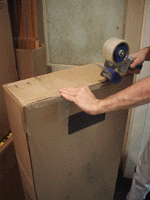 |
Use standard clear or brown mylar box tape, not duct tape. Smooth it down so it really grips the cardboard. Use lots of it, it's cheap. |
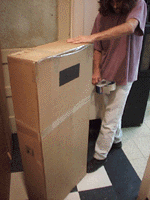 |
UPS will ask you to state the contents. Say: guitar in hard case. Always
insure your package for its full value, and always
keep the papers with a tracking number and so on. |
I have used UPS for many years without significant incident. It remains my first choice. (I dislike FedEx after many incidents, and friends don't let friends even think about OnTrac.) USPS Priority Mail is also good, and usually compares well price-wise, especially on smaller instruments. I have shipped many mandolins and violins through the post office, with no problems. I have only sent guitars a couple of times, but the PO now "dim weights" large boxes like this, so they're less competitive. The advantage of Priority Mail is it's really fast. "Dim-weight" is code term for "dimension weight"—that is, the assigned weight is based on the box dimensions, not the actual weight. That's the way it is. UPS no longer dim-weights Ground packages at their terminal counters. If you have the time and can ship from one of those counters, you get the best price there. Next best price is to call their 800 # and schedule a Next-Day Pickup. It's extremely easy. You give them all the info over the phone, including box dimensions, weight, addresses, declared value for insurance, and so on. And a credit card number. The driver picks it up next day, and the pickup is free. If I am not in a huge hurry, I ship UPS Ground. If it makes you nervous to have an instrument in a system for a week, then consider 3-Day Select or Blue Label which are even faster, but check the upcharges. The UPS "stores" usually charge double the regular UPS price, or worse. They are a rip. And they can seldom pack an instrument right. Avoid them, please. FedEx will often not insure your package if they know an instrument is inside. They can be a real pain, and they're generally much more expensive. They seem to exist mainly for big commercial accounts. Their drivers don't load their vans well, and the vans have no internal restraints, so things get wrecked just as they are driving around. When in doubt, contact me! Paul
Hostetter <music @ lutherie.net> (take
out the spaces) PS: If anyone wants to discuss flying with cellos and basses, contact me privately. Without firm headstock support, this whiplash is often the result: 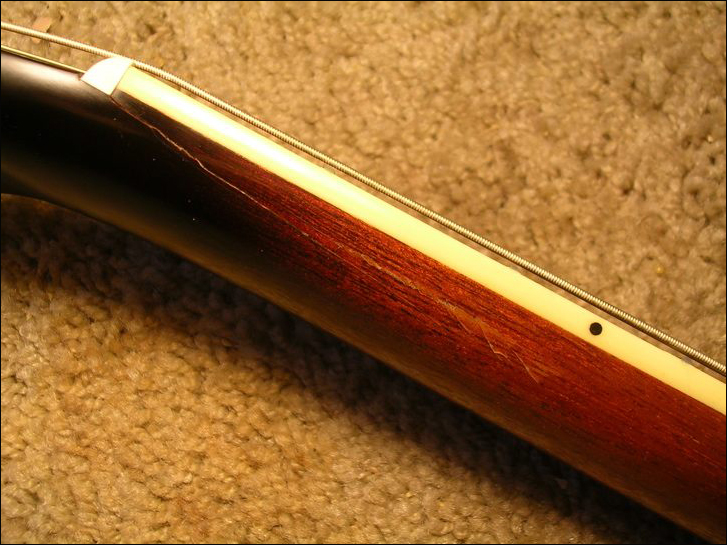 Gibson has set the standard for bad neck design: soft wood, unhelpful grain orientation, plus that big pocket for the trussrod nut, which leaves little wood for strength. This problem is very, very common. 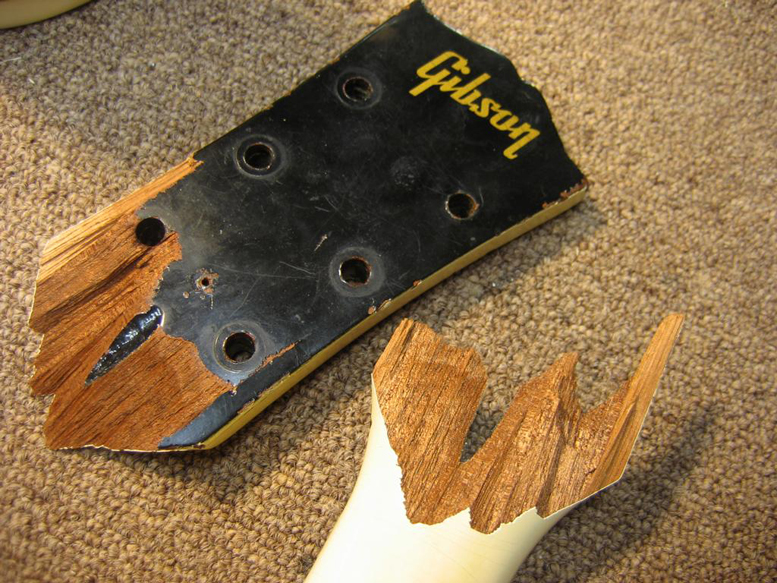 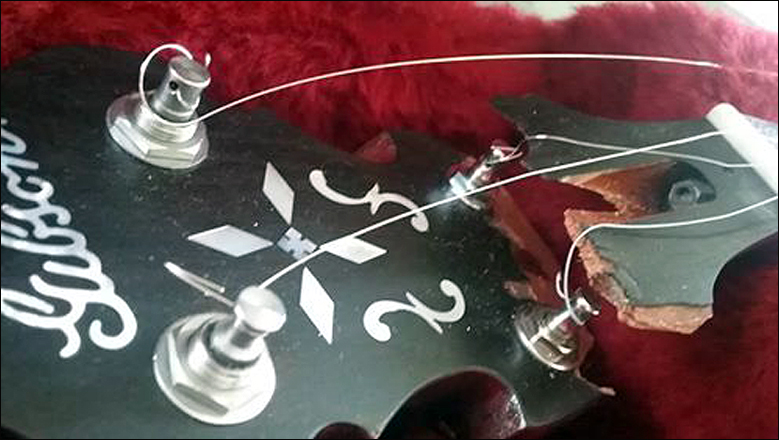 |
|
|
About flying with guitars and other
stringed instruments Thanks to social media, the perennial issue of airline damage has escalated into an epidemic. You know, United Broke My Guitar, etc. We all see that the immediate impulse is to blame the airline. I know I will seem unsympathetic to my fellow musicians, but I see most baggage mishaps as entirely the fault of the passenger who took their favorite guitar (usually, sometimes a banjo) to the airport with expectations of seeing it again safe and sound when they disembarked. Packed properly—in a serious flight case or in a good case then packed inside a shipping carton—things are usually OK. The only instruments you can rely on carrying onboard are small ones such as violins and mandolins—ones in cases that fit the standard carry-on size specifications. The traveler has rights about those instruments. But anything larger is fair game for the Fates. Expecting airline ramp rats to observe a fragile sticker or treat a guitar with kid gloves is unrealistic, to say the least. I've finally also come to acknowledge that even TSA inspectors cannot be trusted to treat your instrument well. Cold hard facts: any guitar (or similar item) in the baggage hold of a commercial flight is luggage. It's not regarded as fragile, it's not a treasure by which you earn your living. No one is in the baggage areas or down in the hold looking after your guitar while it's in transit. And no one in the air travel industry has the slightest bit of sympathy for you or your instrument. It's just another object in the hold, one of many, and you almost certainly signed a piece of paper acknowledging it was inadequately packed when you checked it. Most standard hardshell cases, including urethane foam cases with the aluminum valence, are not flight-safe cases. There's a critical difference between UPS (which flies everything anyway) and commercial flight baggage. UPS packs and transports guitars (or any package) by plane much better than commercial airlines do. In the baggage hold, luggage is loaded fairly loose. It goes up the conveyor and in the door, period. Into a room like this: 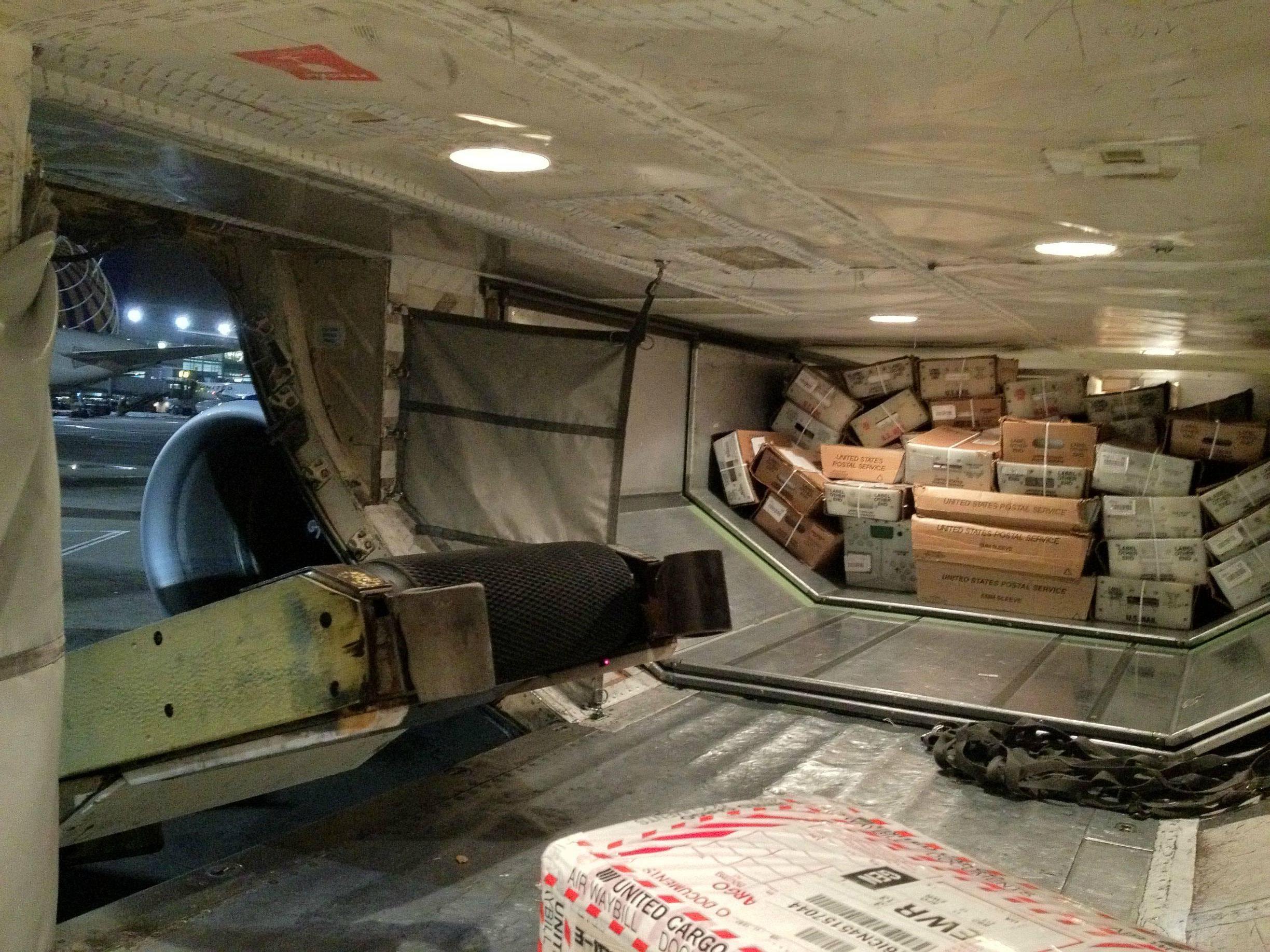 Commercial airline baggage accidents occur when a plane hits turbulence in-flight or when it makes a rough landing, when all the luggage below goes flying and things shift violently and things get bumped and squashed. UPS, by contrast, has very tightly packed pods to maximize the cargo space, and to aid in sorting. Nothing is loose, as it is in commercial baggage holds. 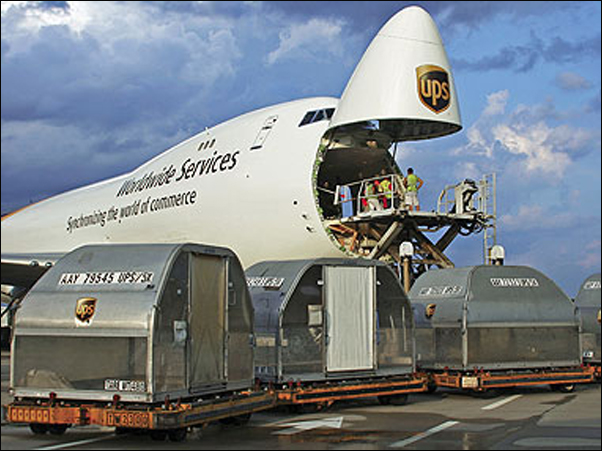 There are many forms of these pods, which are called Unit Load Devices, for various planes 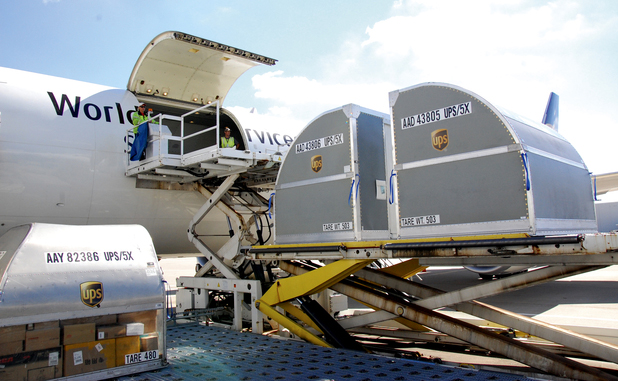 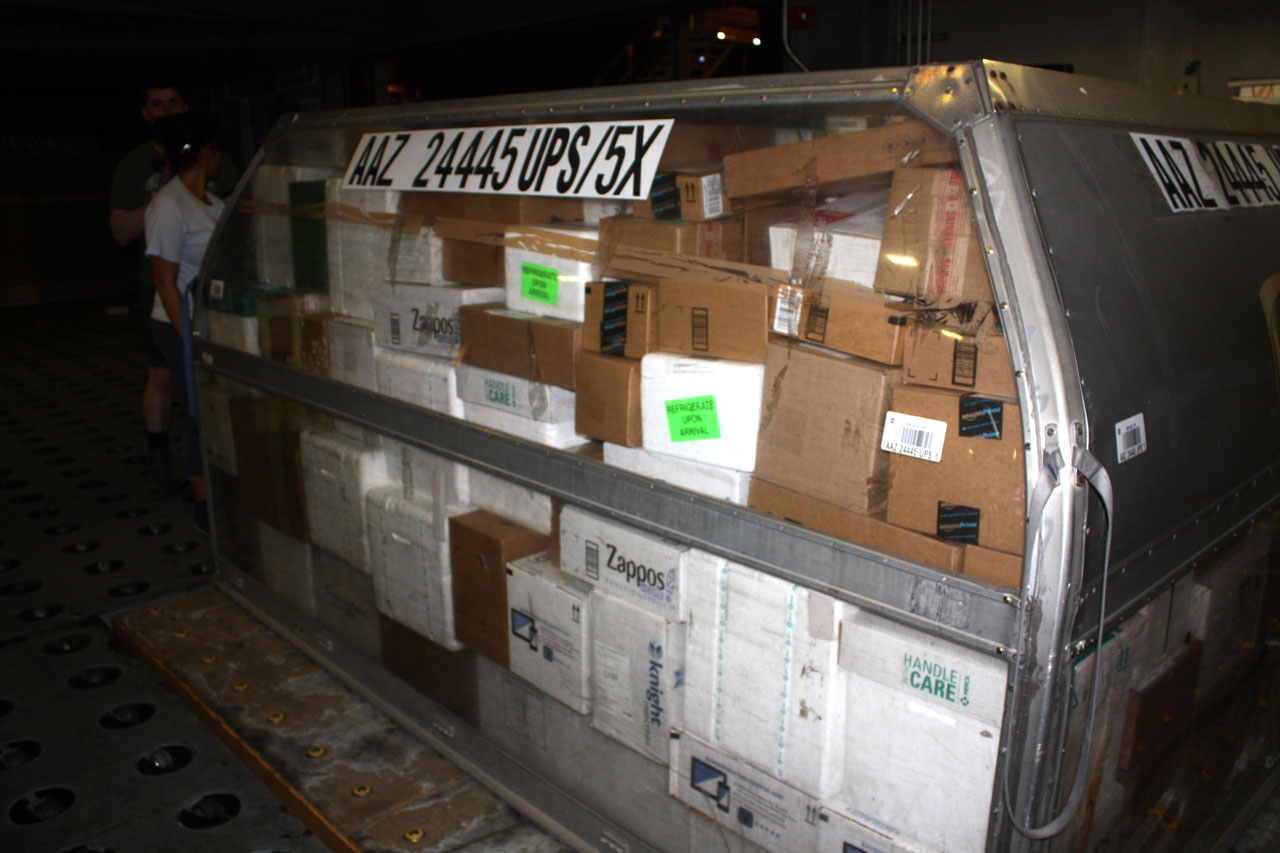 As you can see in the section at the top of this page above, packing a guitar inside a good case with the headstock fully supported and immobilized is the first and foremost consideration. By good case I mean—at the very least—a five-ply wooden case with an arched lid and preferably an arched back too. (Most hard cases are three-ply and many only have flat lids.) Ideally, lacking a serious flight case like a Calton Deluxe (it's all they make now) or a Hiscox Artist flight case, if you had to check a guitar or the like, packing it in its own case inside a shipping box would be best. But you must at least pack the instrument in its case with the headstock completely supported. When you pack the case inside a substantial carton with appropriate inner padding, your guitar stands a chance, though there's always the possibility of a mis-aimed forklift prong and so on. Believe me I have seen it all. Even this can happen:  Most classical guitar cases are pathetically flimsy flattops, nothing more than dust covers really, so they are generally accidents waiting to happen. Many classical guitars also have necks made of Spanish cedar, which is extremely fracture-prone. There are a few decent flight cases, they start around $1000. I own two Caltons and a Hiscox Artist, fitted for particular guitars. No professional touring musician I know doesn't have one like them. Flying with a guitar got better for me with the Voyage-Air, a folding travel guitar, because it easily goes onboard and into the overhead, no questions asked. If I'm flying domestically, and I want to take a better guitar, I use my 6-ply Calton Deluxe, not the simpler 4-ply shell Calton. If I didn't have one of those, I'd pack and ship a guitar ahead, via UPS. Or if I absolutely had to take it with me, I'd pack it as if I was shipping UPS—in a box, as described above—and I'd check it that way. By the way, Japan Airlines is, as of this writing, still offering flight-proof boxes made specifically to accommodate a guitar and other instruments in a normal case. This is a first! If you must fly with an instrument, pack it as if you expect the worst. And sometimes things are simply out of your control. This is Asiana Airlines on the tarmac at SFO not so long ago. Rookie pilot had never landed at SFO, hit the water before quite reaching the runway, skidded onto the tarmac with his landing gear sheared off. Fortunately, the passengers and crew got out just in time, but the plane with their luggage and carry-ons went up in flames. Big oops. Flying ain't what it used to be, and it's highly unlikely it will ever be very good again.  |
|